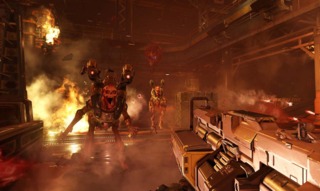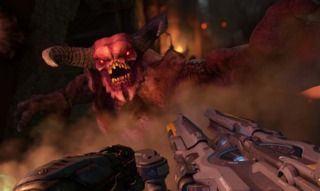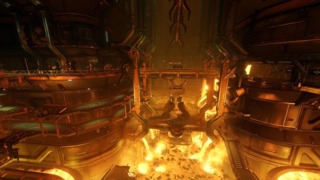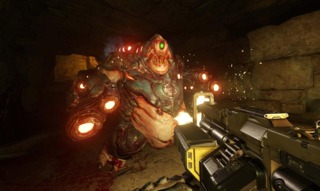
They sure don't make them like this anymore, but then I'm not sure they ever made them like this, period. The new Doom from id Software is an unexpected, masterful combination of hectic old-school shooting, smartly modern design conventions, sharp wit, and a lighthearted reverence, or more accurately, irreverence, for the hallowed legacy of Doom. At least three of those items aren't things I ever expected to see in another Doom game. After eight protracted years of development at id--a time period that included an acquisition by Bethesda, the departure of some legendary founders, and a complete reboot of this game's very nature--you could forgive even the most diehard Doom fan for setting their expectations pretty low. In light of all that, it's astounding this game ended up being as good as it is, but make no mistake: this is one of the most exhilarating, amusing, satisfying shooter campaigns in years, maybe ever.
There's a multiplayer mode and some slightly odd user-created content features in here, but the single-player campaign alone is worth the price of entry, and there are so many great things I want to say about it that it's hard to know where to begin. The best place to start is with the origins of Doom itself, since this new game picks up the tenets of its seminal predecessor and runs with them. The maps are big and complex, with multiple crisscrossing paths, locked doors, and a good amount of backtracking. The shooting is fast, it hits hard, and it never lets you stop moving for a second. You don't even reload your weapons. You don't even reload your weapons!
In short, new Doom plays like classic Doom, but with some modern twists. The big one is the "glory kill," a feature that lets you stagger any monster after putting a certain amount of damage into them, and then launch into a canned execution move that one-hit-kills them. Half an hour with the game allayed my fears that this feature was a concession to mainstream accessibility, for the simple reason that glory kills generate small amounts of health and armor. This makes them an essential part of the give-and-take of Doom's super-fast combat; do you dart into the fray for a glory kill to get a little health back, and risk getting mobbed by all the other enemies around? Similarly, the iconic chainsaw now requires fuel, which initially seemed... dumb. But every chainsaw kill generates a ton of ammo drops, so you have to use it judiciously and save it for when you need to pump your guns back up. There's a satisfying interplay between the benefits of guns, chainsaw, and glory kills that, when combined with the other ways Doom's combat has added to and improved on that of its predecessor, makes the fights in this game excitingly tactical.

Original Doom's combat was certainly frantic, but it largely played out on a single plane. New Doom expands on and adds verticality to this combat flow to a wild degree. The concept of hanging out behind cover certainly doesn't exist in this game. Instead you'll constantly bob and weave between enemies that chase you constantly, and projectiles that are just barely slow enough for you to dodge them. With a double jump and the ability to mantle onto ledges, you've got strong mobility options, but the enemies, even the big ones, are actually able to get around the environment just as nimbly as you can. Watching them scramble and leap between platforms and up ledges is one of those moments where you want to stop and marvel at how far enemy behavior in shooters has come--except you can't sit still, because the monsters in this game will hunt you ceaselessly until you reduce them to gore and cinders. It's another great element that makes the action feel like it just never stops moving, and it's a huge step up from shooters where the opposition largely hangs out behind boxes taking pot shots at you. As a rule I generally review games on their default difficulty, but I played through this one on Ultra-violence because, c'mon, it's Doom. This game is at its best when you're constantly one or two hits away from death, forcing you to stay on the move as you juke around imp fireballs and look for that next glory kill or ammo pickup to get you back in the fight. I don't feel this way about every game, but this one's combat is of that rare high quality that warrants the challenge.
The demonic menagerie, the comic-book sci-fi arsenal, the host of '90s shooter tropes; it's all classic Doom, from pinky demons to colored keycards (and skulls!), cacodemons to megahealth to the BFG 9000. And yet none of it feels dated. There's a ton of subtle, loving attention to detail in various sound effects, enemy designs and behaviors, and giant demonic skulls that evoke the look and feel of classic Doom without beating you over the head with it. At the same time, all of these elements are housed in a game that feels like the perfect blend of throwback gameplay and modern, upgrade-system-driven design philosophy. Upgrade systems seem anathema to the spirit of Doom, and thus you may be horrified to hear there are literally half a dozen different types of upgrade points, weapon mods, and challenge systems in here. But all of these systems feed back into and enhance the way you play the game in delightful ways, with weapon mods that encourage you to experiment with unconventional shooting tactics and a rune-based ability system that lets you pick interesting enhancements like extra air control, or unlimited ammo when your armor is above a certain threshold. Upgrading your weapon mods and runes involves fulfilling unique little challenges that are fun to complete in their own right, nevermind the gameplay benefits they yield.

The game tucks away secret areas just like the old Doom games did, and not only do these spots house a bunch of goofy easter eggs, they provide gameplay bonuses like extra upgrade points and the ability to get most of the campaign's weapons earlier than you would otherwise. One of the first available character upgrades will actually mark most of the secrets right on your map. This doesn't make getting the secrets easier, because finding where they are isn't the challenge; ferreting out and navigating the obscure path to actually get to them is. Accessing a secret feels like solving an environmental puzzle, and it's fun and very Doom-like to backtrack through a level that's quiet and devoid of enemies, exploring all the nooks and crannies to get everything you missed. Actually, my only major complaint about Doom's campaign is that the first half of the game trains you to expect you'll always be able to go back and explore for secrets, but then a handful of the later levels arbitrarily close doors behind you or block off your return path every 10 minutes, preventing you from backtracking to a secret you may have missed just a couple minutes before. At least you can replay any mission at any time and all previous secrets will feed back into your current campaign progress, but I would have appreciated more consistency in what's otherwise a really well thought-out exploration component.
Improbably, the one way this game both breaks from and elevates its predecessors is through its storytelling. If you'd told me prior to release that a new Doom game would have a plot at all, let alone one I'd become weirdly invested in, I'd have laughed in your face. After I'd played Doom, I was laughing for different reasons. This game hilariously, wordlessly sets itself up as a direct sequel to Doom II when, in the very first scene, your marine wakes up on an inscribed stone slab and finds his vaunted green armor enshrined in glyphs and candles. Yes, this game takes the original irrelevant video game protagonist, a nameless nobody so generic he's only ever been referred to as "Doomguy," and reimagines him as nothing less than a divine avenger so unstoppable that over the course of two games he left a Biblical mythology in his wake. It's so deliciously absurd I can't believe someone thought it up, let alone had the guts to make it the through line of a big-budget shooter from a major publisher.

And yet things just get crazier from there. The whole thing is set on a Mars that's become a galactic power plant by way of siphoning "Argent plasma" through a portal to the demon realm. Yes, mankind solved its ongoing energy problems by... fracking Hell. The game doesn't dwell on this point, but rather takes it in stride as it cynically explores the office politics of harnessing the devil for shareholder gain. I encourage you to check out every data log you can get your hands on, so you can read the employee handbook's guide to a level 3 demon contamination event ("Simply close your eyes, kneel down, and wait. Remember you can be as useful in death as you are in life.") or ludicrous corporate memoranda about the "project to weaponize the demons." An ever-present company hologram man hangs around to provide some great rah-rah corporate cheerleading. ("The road to Hell is paved with... Argent energy!") There's a lot of darkly comedic stuff in here, and it's all somehow gloriously stupid and extremely smart at the same time. Whoever wrote this game deserves a medal.
These days it doesn't seem especially worth mentioning how good a game looks unless it really goes above and beyond, but Doom is definitely one of those games. Naturally it looks the best on a PC with a current GPU, and damn does it look good there. It's also worth noting that it still feels great to play with a mouse and keyboard--provided you turn off the swimmy mouse acceleration--which a lot of games that are developed primarily with consoles in mind don't seem to manage these days. (To give an idea of just what a throwback this game feels like, one of my favorite moments came when I was curious how my old Geforce 670 was performing at home, and I instinctually hopped into the console and threw in "com_showFPS 1" without even thinking about it. Yep, definitely an id game.) The bigger story here is how incredible this game looks and runs on console, though. The console versions use significantly lower quality shadows, particle effects, and so on than on PC, but not only do they still look better than most other console games, the PS4 version I played through also ran at a locked 60 fps the whole way through. That performance is critical given how fast the combat moves, so it's great to see the game running so smoothly on console and looking so good at the same time. The days of massive generational leaps in technology between game engines--leaps that at one time were almost singlehandedly driven by id games--seem to be behind us, but it's nice to see id Software can still bring it with the best of them in graphics terms.
Doom has what seems to be a relatively in-depth user-created content system with perhaps the best possible name in Snapmap. Snapmap! Here you get a reasonably intuitive map-building interface that even works well on a controller, which lets you build levels by stitching together and reorienting a decent assortment of premade rooms. You can place enemies, define behaviors, set environmental triggers and sound sources, and so on. Snapmap has a nice matchmaking feature via competitive and co-op playlists, and these playlists currently offer some lovably janky maps with rulesets that are able to capture a bit of the feel of classic Doom deathmatch, at least moreso than the game's actual multiplayer mode does. There are also maps featured on the Snapmap community page that let you play rudimentary musical instruments and do some puzzle-solving, so the tools here seem geared toward creating weird stuff outside the standard combat. And the most-popular list currently features a remake of E1M1 (surely the shooter equivalent of 1-1) and several 10-second "EARN POINTS FAST!!!1" farming maps, so you know this is a proper user-created content mode. Unfortunately, id isn't planning to release more robust, traditional mod tools (though who knows what industrious PC modders will end up pulling off), and new user creations have only been sort of trickling out in the week since launch. As always, it'll take some time before anyone populates the store with really interesting maps, so it's tough to say right now what kind of legs Snapmap will actually have. But the tools on offer at least seem tentatively promising.

And then there's the actual competitive multiplayer, which a lot of players have gotten a taste of through several beta periods prior to launch. Where Doom's campaign is eminently true to itself and the Doom legacy, the multiplayer feels a bit too much like it's chasing other contemporary online shooters, what with its preset loadouts, single-use XP items, and two-weapon limit. Yes, it's fast-paced and has you bouncing through the air off of jump pads, and it comes with a standard assortment of team-based objectives modes (though, bafflingly, not free-for-all deathmatch) but it doesn't hearken back to Doom in the right ways. I would've preferred a multiplayer component that took more cues from the Doom and Quake era. The idea that you've got Doom multiplayer where every weapon isn't available on the map as a pickup just feels wrong (though at least the Snapmap matchmaking options somewhat act as a classic deathmatch substitute). What's here isn't bad, it's just a little too similar to other available shooters to feel like it's worth sticking with. It doesn't stand out from the rest of the market the way the game's campaign does.
Those other components are all well and good, but it's that campaign in Doom you absolutely need to see. The majority of Doom's original creators may have moved on from id by now, but this game still looks, plays, and feels like it was made by a group of people who not only understand Doom but respect and love it. It ticks off every item on a list of things a modern Doom should have, including several items you didn't even know were on the list in the first place. They may not make shooters like this anymore, but the runaway success of this game serves as long overdue proof that they really should.